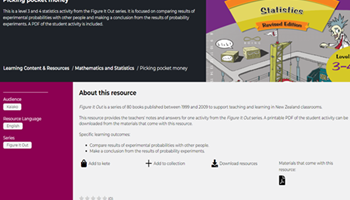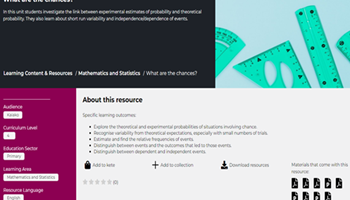Planning tool
Year levels
Strands
Expected level of development
Australian Curriculum Mathematics V9: AC9M6P02
Numeracy Progression: Understanding chance: P4
At this level, students predict the frequency of an outcome of repeated chance experiments. They conduct simulations using digital tools to generate and record the outcomes, and observe the effect of many trials on the outcome. They then compare observed and expected frequencies of the outcomes of chance experiments.
Through investigation and use of simulations expect that students find, as the number of trials increase, the combined results of the equally likely chance experiment will begin to show that the actual frequencies move closer to the expected frequencies (theoretical probability).
Connect students’ prior learning of fractions, decimals, percentages and their equivalences to the relative frequencies of outcomes of chance experiments. It is expected that students have already learned about possible outcomes of chance experiments.
Students are also introduced to repeated chance experiments. Explain that theoretical probability is what we expect to happen, and experimental probability is what actually happens when we try it out by conducting an experiment. Students conduct repeated chance experiments, such as coin toss, spinners and dice rolls, recording the results of each trial in a table. Data collected can then be analysed to look for patterns in the relative frequencies of outcomes with these also represented as percentages. Use questioning to prompt students to analyse and explain patterns in the data.
Make explicit the need for larger trials and the effect this has on the observed results. In small trials, students may observe that the expected frequencies (theoretical) differ from their experimental results. Small trials may initially be conducted by hand, however using digital tools and computer-based simulations enable large trials to be conducted in a timely and efficient manner. Differentiated teaching strategies can include using digital tools. Students can conduct experiments with a small set of equally likely outcomes that are easier to see concretely as well as conceptualise abstractly after a large number of simulated trials. When extending students they can work with outcomes that are not equally likely, for example, biased spinners.
This topic incorporates connections to statistics, interpret and compare data sets for ordinal and nominal categorical, discrete and continuous numerical variables (AC9M6ST01) and plan and conduct statistical investigations (AC9M6ST03).
Teaching and learning summary:
- Use digital tools to simulate repeated random experiments to recognise emerging patterns.
- Make connections to prior learning about fractions, decimals and percentages.
- Provide physical materials and digital tools to conduct repeated trials of chance experiments and explore the effect of using a larger number of trials.
- Use questioning to prompt students to begin to understand that the actual frequencies move closer to the expected frequencies in equally likely chance experiments.

Students:
- describe probability in terms of what they expect to happen
- design and conduct an experiment and collect and analyse data to determine how likely it is something will happen
- explain the effect on the outcome of a chance experiment when increasing the number of trials
- apply their understanding of fractions and percentages to express probability of events
- use simulations to model chance experiments
- reason that if the outcomes are equally likely then over a large number of trials the total frequencies begin to even out.
Some students may:
- be confused when comparing observed frequencies and expected frequencies as they may not yet understand why observed frequencies might produce different results to expected frequencies. Conduct experiments where students must record the results, that is, their observations. They can then compare these to the expected results. For example, the probability of rolling a 6 on a die is 16 , so this would be the expected probability. This means if the die was rolled 600 times, it would be expected the number 6 would come up 100 times.
- Conduct an experiment where the students roll the die 10 times and record the results for each roll (a frequency table could be used to record results). At the end of the experiment, they tally the number of times a 6 appeared. For example, the number 6 may have come up 2 times in the 10 rolls. As a fraction, this would be written as 210 , which simplifies to 15 .
- In this case, the observed frequency does not match the expected frequency. Discuss why this is the case. Ask students to think about how to achieve an observed result that is closer to the expected result. What would happen if we rolled the die another 10 times and then another 10 times again? Digital tools enable students to efficiently do this.
- incorrectly believe that similar to rolling one die where there is a 1 in 6 chance, rolling 2 dice would have a 1 in 12 chance of rolling a total. However this is not the case. For example, rolling a total of 7 has a 6 out of 36 ( 16 ) chance whereas rolling a total of 4 has only a 3 in 36 chance ( 112 ).
- confuse events with outcomes, for example, when rolling two dice and getting a total of 3 the outcome of [2,1] is different to [1,2] however the outcome is still a total of 3. There are two chances out of a possible of 36.
To address these, ask students to conduct repeated chance experiments, recording and interpreting the results.
The Learning from home activities are designed to be used flexibly by teachers, parents and carers, as well as the students themselves. They can be used in a number of ways including to consolidate and extend learning done at school or for home schooling.
Learning intention
- We are learning to conduct chance experiments.
Why are we learning about this?
- We are learning to predict and determine probabilities.
What to do
1. Open the simulation Spinners: explore.

a. Conduct a repeated chance experiment using the spinner.
b. Describe the likelihood of a particular colour being chosen.
2. Open the simulation Spinners:explore.

a. Conduct a repeated chance experiment using the spinner.
b. Observe the effect of increased number of trials.
Take screen captures of your simulations and explain your results.
Success criteria
I can:
- make predictions based on data
- identify all possible outcomes of an event
- explain the effect of larger trials on observed outcomes of chance experiments.
Please note: This site contains links to websites not controlled by the Australian Government or ESA. More information here.
Teaching strategies
A collection of evidence-based teaching strategies applicable to this topic. Note we have not included an exhaustive list and acknowledge that some strategies such as differentiation apply to all topics. The selected teaching strategies are suggested as particularly relevant, however you may decide to include other strategies as well.
-

Explicit teaching
Explicit teaching is about making the learning intentions and success criteria clear, with the teacher using examples and working though problems, setting relevant learning tasks and checking student understanding and providing feedback.
Go to resource -

Mathematics investigation
By giving students meaningful problems to solve they are engaged and can apply their learning, thereby deepening their understanding.
Go to resource -

Questioning
A culture of questioning should be encouraged and students should be comfortable to ask for clarification when they do not understand.
Go to resource -

Differentiated teaching
Differentiation involves teachers creating lessons that are accessible and challenging for all students.
Go to resource -

Feedback
It has been shown that good feedback can make a significant difference to a student’s future performance.
Go to resource -

Collaborative learning
For group work to be effective students need to be taught explicitly how to work together in different settings, such as pairs or larger groups, and they need to practise these skills.
Go to resource -

Multiple exposures
Providing students with multiple opportunities within different contexts to practise skills and apply concepts allows them to consolidate and deepen their understanding.
Go to resource
Teaching resources
A range of resources to support you to build your student's understanding of these concepts, their skills and procedures. The resources incorporate a variety of teaching strategies.
-

Theoretical and experimental probability
Use these tasks to compare experimental results with expected frequencies. Look at the effect of increased number of trials.
Go to resource -

Spinners explore
Use this simulation for students that need scaffolding when investigating probabilities by using repeated chance experiments.
Go to resource -

Mystery spinner: challenge
Use this simulation for students that need scaffolding when investigating probabilities by using repeated chance experiments. Observe the effect of increased number of trials.
Go to resource -

Tricky track
This activity is a practical way to compare experimental and theoretical probability.
Go to resource -

Introduction to probability: the rolling of a die
Use this GeoGebra dynamic software to simulate the rolling of a die to compare experimental probability to theoretical probability. Observe the effect of a larger number of trials.
Go to resource -

Experimental probability
Use this GeoGebra dynamic software to enter experimental probability as a fraction.
Go to resource -

Dice roll simulation (with graph and large trials)
This GeoGebra dynamic software rolls two dice and visualises this repeated chance experiment by showing the outcomes as a histogram. Observe the effect of a larger number of trials.
Go to resource -

Last one standing
Use this task, which includes a simulation of a repeated coin toss by 16 people, to enable students to use proportional thinking and apply their understanding of probabilities.
Go to resource -

Picking pocket money
This is a level 3 and 4 statistics activity from the Figure It Out series. It is focused on comparing results of experimental probabilities with other people and making a conclusion from the results of probability experiments. A PDF of the student activity is included.
Go to resource -

What are the chances?
In this unit students investigate the link between experimental estimates of probability and theoretical probability. They also learn about short run variability and independence/dependence of events.
Go to resource

